Panasonic Viera TX-P50VT20B 50in Plasma 3D TV Review
Panasonic Viera TX-P50VT20B 50in Plasma 3D TV
It's Panasonic's first 3D TV and as far as televisions go, it's pretty awesome.
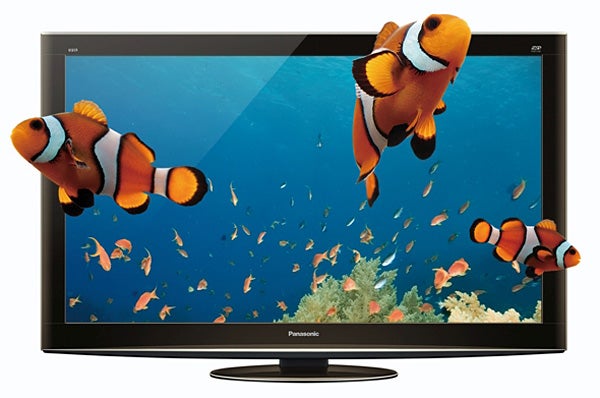
Verdict
Pros
- Good 3D performance, with almost no crosstalk
- Freeview/Freesat HD tuners included
- Unbeatable black levels
Cons
- Doesn't side-step the usual 3D issues
- Weak 3D glasses design
- No 2D-to-3D conversion
Key Specifications
- Review Price: £2295.00
- 50-inch 1080p panel
- Records to USB (with compatible external HDD)
- 4 HDMI slots (all 3D-capable)
- 5,000,000:1 contrast ratio
- DivX HD playback from USB/SD
The wait is finally over. After countless 3D-related press trips and technical forums, then some frustrating further delays created by the Icelandic ash cloud travel chaos, Panasonic has at last presented us with its debut 3D TV, the 50in TX-P50VT20B.
Thankfully, Panasonic has decided to celebrate – albeit moderately – the launch of its first 3D TV by taking its design blinkers off – or at least, shifting them a bit to the side! For instead of the usual muted black, the P50VT20B enjoys a bronzey brown colour that’s more appealing in the flesh than it sounds on paper.
The finish feels slightly plusher than with sets lower down Panasonic’s range, too, and the appearance of some bold silver trim to top and bottom doesn’t hurt the decently opulent overall look. We appreciated having a few degrees of angle adjustment via the TV’s rotating stand, too.
Despite all this, though, set beside Samsung’s UE55C8000 3D edge LED model, with its glinting metallic finish and ultra-slim body, the P50VT20B still looks chunky, plain and old-fashioned – bronze colour or no bronze colour.
Connection-wise, the P50VT20B covers all the important bases. Four HDMIs set the ball rolling – and yes, as you’d expect of a 3D TV, all these HDMIs are built to the new 3D-compatible v1.4 specification. Only one of the HDMIs is compatible with HDMI v1.4’s audio return channel – but this is fair enough, as it’s hard to imagine anyone needing more than one!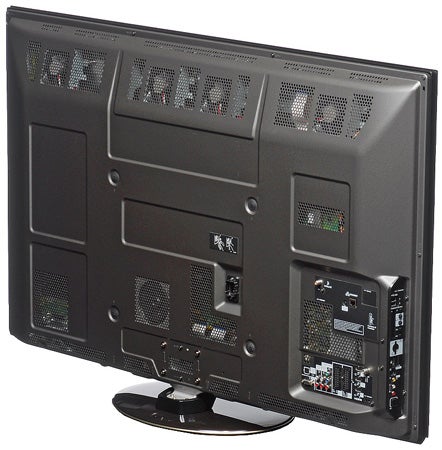
The P50VT20B is on the money in multimedia terms too, boasting not one but two USB inputs plus an SD card slot for direct playback of photo, music and video files, including DivX HD.
There’s also an Ethernet port for accessing either files on a DLNA PC, or Panasonic’s solid though hardly inspiring Viera Cast online service. Alternatively, you can make the TV Wi-Fi-enabled via a USB dongle that’s included as standard.
If we wanted to be churlish, we might wonder why the Wi-Fi abilities couldn’t just have been built into the TV’s chassis. But we’re just not in a churlish mood today!
Other connections of note include a D-Sub PC port, an optical digital audio output, and last but certainly not least, both RF and LNB inputs. These latter two jacks are significant because they prove that the P50VT20B carries both built-in Freeview HD and Freesat HD tuners. Panasonic is currently the only brand offering such an integrated, all-encompassing free-to-air HD broadcast solution – handy given that currently only a few parts of the UK can receive Freeview HD broadcasts.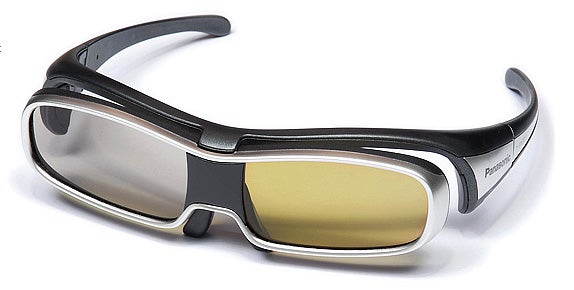
The USB Wi-Fi dongle mentioned earlier isn’t the only key accessory included in the P50VT20B’s packaging. For there are also not one but two pairs of active shutter 3D glasses. This is a significant act of generosity from Panasonic given that the EW3D10 glasses involved cost 100 quid apiece. And it throws into stark relief Samsung’s decision not to include any glasses as standard with their 3D TVs (though you can get one pair sent to you if you register your Samsung TV).
Of course, families will still be looking at forking out for at least one extra pair of glasses, but we still applaud Panasonic’s decision to include two.
One final connection-related feature we must mention is video recording to HDD via the USB sockets. As we’ve noted with other reviews of current Panasonic TVs, this recording ability is limited in that you can only watch what you’ve recorded from the HD tuners on the same TV you recorded it on. Plus you are severely restricted over which USB HDDs to use; only Buffalo’s JustStore Desktop HD-EU2-UK series are confirmed to work.
But the quality of the recordings you can make is excellent – they’re identical, so far as we can tell, to the original broadcasts.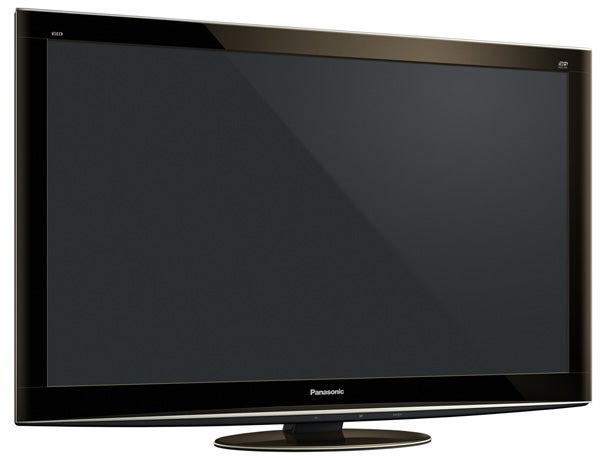
A voyage through the P50VT20B’s rather bland but straightforward onscreen menus uncovers a number of interesting points. Starting with the provision of both a THX picture preset, and two ‘professional’ presets that can be used for calibration by an expert from the Imaging Science Foundation.
Also worth a mention are a Vivid Colour option that does exactly what it says on the tin (but which will likely be avoided by AV purists); a colour management tool allowing you to tweak the gain and cut-off settings for the red, green and blue colour components; six gamma presets (of which you should stick with the 2.4 or 2.2 settings for the most part); and Panasonic’s 600Hz Sub-field drive Intelligent Frame Creation judder reduction processing.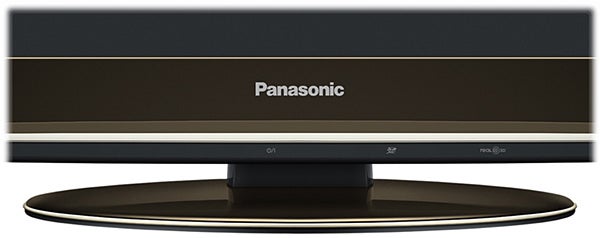
The technology inside the P50VT20B is important too, for as well as the latest Panasonic NeoPDP design with its improved gas, phosphors and cell design, the set enjoys new high-speed driving circuitry. This is potentially hugely significant, because it substantially reduces each plasma cell’s ‘decay time’ – the time, in other words, that it takes for a cell to finish showing the content for one frame of the image and get on to showing the content for the next frame.
This matters because it should reduce the crosstalk 3D phenomenon, where you can see ghostly second and even third images around bright, contrasty or very linear 3D content.
Finally, despite our healthy mistrust of manufacturer’s quoted contrast ratios, we can’t help but feel impressed by the 5,000,000:1 native (as in, without dynamic contrast processing) contrast ratio claimed by the P50VT20B’s Infinite Black Pro technology.
And so, finally, we get to the moment of truth. Will the P50VT20B’s 3D performance live up to all of Panasonic’s relentless hype?
D glasses for Panasonic Viera Plasma 3D TV.” width=”300″ height=”120″ class=”align size-medium wp-image-213547″ srcset=”https://www.trustedreviews.com/wp-content/uploads/sites/54/2010/06/13328-glasses-1.jpg 500w, https://www.trustedreviews.com/wp-content/uploads/sites/54/2010/06/13328-glasses-1-300×120.jpg 300w, https://www.trustedreviews.com/wp-content/uploads/sites/54/2010/06/13328-glasses-1-320×128.jpg 320w” sizes=”(max-width: 300px) 100vw, 300px” />
The first thing to say about the P50VT20B’s 3D experience isn’t positive. For we really don’t like Panasonic’s 3D glass design at all. For starters, the lenses are set quite some distance from your eyes, without any ‘boxing’, which lets in all kinds of distracting light unless you’ve got your room almost completely dark.
We also didn’t find the glasses as comfortable on our noses as the Samsung ones, making the thought of watching, say, a four hour tennis match in 3D a potentially painful experience.
Next, we found the set’s 3D options a touch odd. First, there’s no 3D control button on the remote control, meaning you have to head into the onscreen menus just to switch the TV to different 3D modes. Silly.
The 3D sub-menu also contains some quirky feature complications not noticed on the Samsung model. You can reverse the 3D left/right sequence, for instance, if – according to the rather vague manual – ‘you feel that the sense of depth is unusual’. We can’t really imagine when such a feature would become necessary, but maybe we’ll stumble across a relevant situation in the 3D future.
There’s also an ‘Edge Smoother’ designed to remove (as in, ‘soften away’) the slightly jagged look to contoured edges that can occur with side by side or top and bottom 3D formats.
There’s even a mode for turning a 3D image into a 2D one should not everyone in the room have 3D glasses when watching something on a 3D channel. But there’s no 2D-3D conversion like you get with the Samsung set.
Settling down to watch (on Panasonic’s BDT300 3D Blu-ray player) our currently only 3D alternate frame Blu-ray source, ”Monsters Vs Aliens”, the P50VT20B makes an instant and profoundly good first impression by suffering far less with crosstalk noise than Samsung’s 3D LED TV.
All of the subject matter which showed the crosstalk ghosting all too clearly on the Samsung TV – the tension ropes of the golden gate bridge, the mid-range shot of the robot monster walking towards the bridge, etc – is here reproduced with only the tiniest trace of echo images. In fact, for the majority of the time, the crosstalk noise is negligible, even over background image content.
Switching to the Sky ‘side by side’ 3D channel and a repeat showing of the Championship play-off final, and the crosstalk story is the same. As in, there’s hardly any of it, making the players look cleaner and the image thus more consistent throughout its depth than on the Samsung LED set.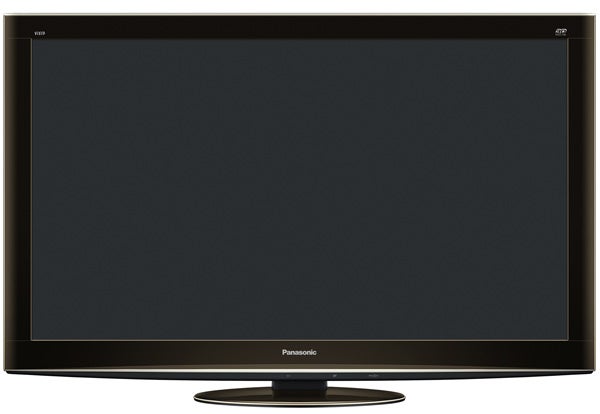
Samsung has tried to combat crosstalk with its LED TVs via a new, faster driving system and sophisticated processing system that introduces blank frames to the image in a bid to get round LCD’s inherent response time issues. And they’ve talked at length about plasma’s decay time issues potentially causing the same problems as LCD’s response time issue. But the simple fact, obvious to anyone who cares to watch them side by side, is that Panasonic’s plasma 3D system simply doesn’t suffer from crosstalk nearly as much as Samsung’s LEDs.
It’s worth adding, too, that unlike the Samsung LED TV, the P50VT20B doesn’t have to warm up for a couple of hours before it’s able to deliver its best 3D efforts.
The P50VT20B additionally delivers motion in 3D mode with great clarity, and with little if any noteworthy judder. And the sense of depth and ‘3D-ness’ it portrays appears comparable to that of the Samsung C8000 series. But the lack of crosstalk somehow makes its 3D images look more solid.
The lack of crosstalk noise has its most significant positive impact with games. For the Xbox 360’s ”Avatar” 3D game looks significantly cleaner on the P50VT20B, to a degree that actually makes it more fun to play. Which is saying something considering what a poor game it is.
Plasma’s inherent advantage when it comes to contrast, meanwhile, helps it deliver a richer and more convincing black colour than the sometimes rather grey effort of the Samsung UE55C8000 TV we’ve seen.
However, the P50VT20B doesn’t have everything its own way in 3D mode. For starters, its 3D images, once you have your glasses on, are substantially darker than both the set’s 2D images and the 3D images from Samsung’s LED 3D sets. Panasonic itself has suggested that the brightness reduction could be as much as 80 per cent.
This isn’t as much of an issue as it sounds in a dark room, except for the way the darkness actually pushes out of the visible spectrum a degree of shadow detail during particularly dark scenes. But if your viewing room is very bright, the lighter LED approach might suit you better.
The P50VT20B’s colours with 3D footage, meanwhile, look muted versus the strikingly vibrant ones of the Samsung C8000 3D TVs, a fact which also means that the Panasonic’s colour tones look slightly less natural at times.
In fact, thanks to these brightness and colour vibrancy issues, we found ourselves surprisingly inclined to use a tweaked version of the P50VT20B’s Dynamic picture preset for 3D rather than the Cinema or THX modes we tended to use during 2D viewing. 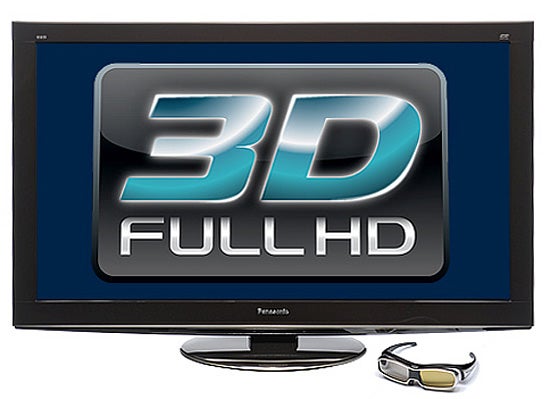
Panasonic has repeatedly claimed that the panel technology it’s devised with 3D in mind will also help the P50VT20B’s 2D performance. And actually, this seems to be true.
Particularly startling is the TV’s contrast. For alongside the brightest (minus 3D glasses) and most vibrant light image content Panasonic has produced to date sits the deepest, most natural and involving black level Panasonic has produced to date. In fact, the richness of its black level – a crucial component in any home cinema TV – even clearly surpasses that of the brand’s already impressive G20 plasma series, leaving it offering the best black level response found on any TV available today.
Its colours during 2D viewing are superb too, combining levels of dynamism, tonal accuracy and blend subtlety never before seen on a plasma TV. Or at least that’s the case with HD and high quality standard def fare; colours do lose accuracy and vibrancy with grubby, low-quality standard def broadcasts. But this is common in the flat TV world.
Another great strength of the VT20 is the sharpness of its HD 2D pictures – and its HD 3D ones for that matter. The screen makes all of our favourite HD sources look effortlessly crisp, immensely detailed, and full of texture without being in the least bit noisy.
The clear motion noted with 3D holds true with 2D too, especially if you engage the Intelligent Frame Creation or 24p Smooth Film modes (though only use their lowest power settings if you want to avoid processing side effects).
Joining the P50VT20B’s stellar picture performance is a decent audio effort. The bamboo speakers the set uses deliver more distortion-free power, dynamic range, clarity and detail than other TVs we’ve heard from Panasonic’s new range. There’s still room for improvement, though, particularly at the bass end of the spectrum.
Verdict
The P50VT20B is comfortably the finest mainstream TV Panasonic has ever produced, and one of the finest TVs ever seen period. And that’s even before taking its 3D talents into account.
These 3D talents aren’t perfect, and leave Samsung’s LED alternative with enough wriggle room in the brightness and colour departments to make them seem merely a different option for different tastes/room environments rather than actually inferior.
But if you put a gun to our head and asked us to choose which 3D experience we personally prefer, bearing in mind our dark rooms and love of gaming, the answer, due almost exclusively to its impressive freedom from crosstalk noise, would be Panasonic’s.
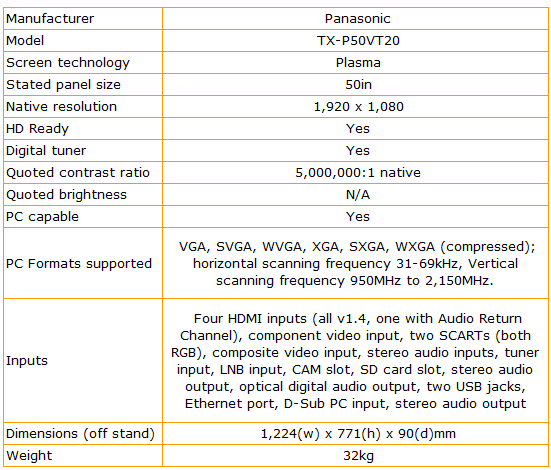
How we test televisions
We test every TV we review thoroughly over an extended period of time. We use industry standard tests to compare features properly. We’ll always tell you what we find. We never, ever, accept money to review a product.
Trusted Score
Score in detail
-
Features 10
-
Value 9
-
Image Quality 9
-
Design 7
-
Sound Quality 7
Features
| Size (Inch) | 50in |
| Display Type | Plasma |
| Max. Resolution | 1920 x 1080 |
| Digital Tuner | ATSC, DVB-S2, DVB-T (MPEG4), DVB-C (MPEG4) |
| 3D Ready | Yes |
| Contrast Ratio | 5000000:1 |
| Refresh Rate (Hertz) | 100Hz |
Physical Specifications
| Height (Millimeter) | 810mm, 59.6mm |
| Width (Millimeter) | 335mm, 103mm, 1224mm |
| Depth (Millimeter) | 90mm |
| Weight (Gram) | 27.50g |

